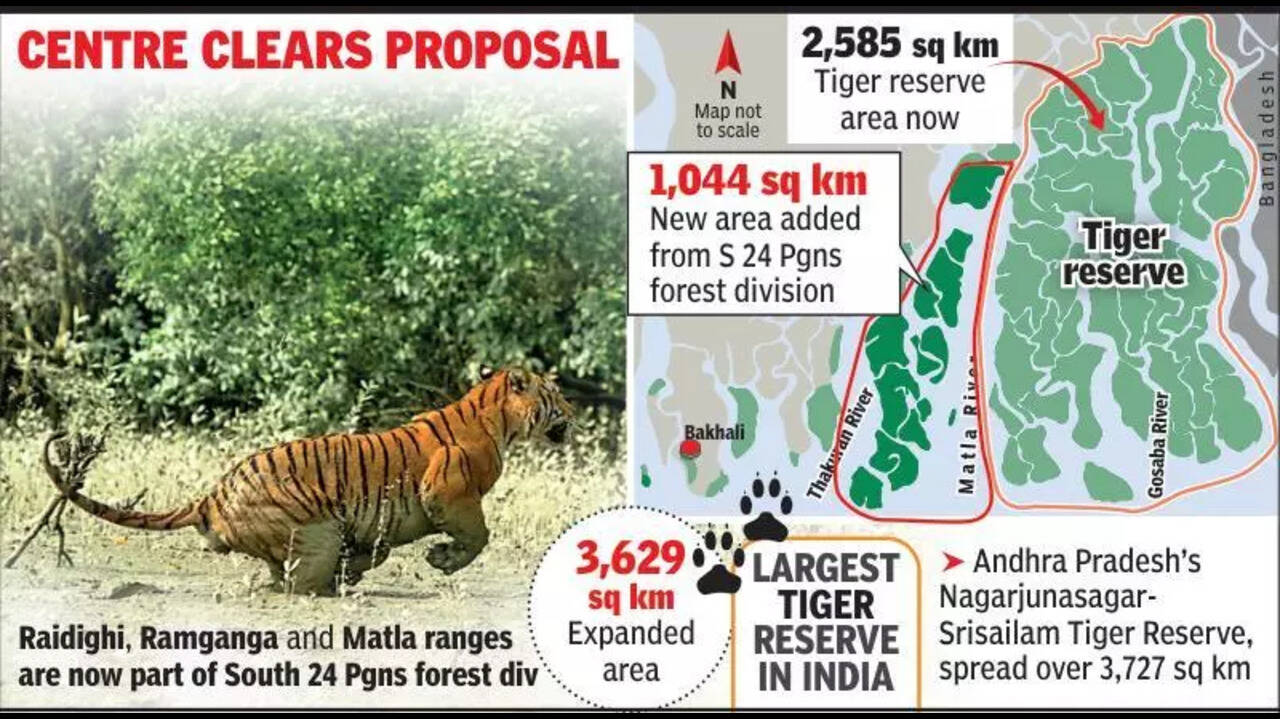Context:
The National Board for Wildlife (NBWL), chaired by the Union Minister of Environment, Forest and Climate Change, has approved West Bengal’s proposal to expand the Sundarbans Tiger Reserve (STR). With this expansion, STR’s area will increase by 1,044 sq km, elevating it from the 7th to the 2nd-largest tiger reserve in India—just behind Andhra Pradesh’s Nagarjunasagar-Srisailam Tiger Reserve.
Procedure to Declare or Alter a Tiger Reserve
Tiger Reserves are governed under the Wildlife (Protection) Act, 1972.
As per Section 38V – Declaration Process:
1. Proposal submitted by the State Government
2. In-principle approval by the National Tiger Conservation Authority (NTCA)
3. NTCA conducts due diligence and recommends to the State
4. The State Government notifies the area as a Tiger Reserve
As per Section 38W(1) – Alteration Process:
- No boundary changes allowed without approval from the NTCA and NBWL
- Proposal must originate from the State Government
- Final approval lies with the National Board for Wildlife (NBWL)
About Sundarbans Tiger Reserve (STR):
|
Attribute |
Details |
|
Location |
Coastal districts of West Bengal |
|
Unique Feature |
World’s only mangrove habitat with a significant tiger population |
|
Established |
1973 under Project Tiger |
|
UNESCO Status |
World Heritage Site and part of Sundarbans Biosphere Reserve |
|
Ecological Importance |
Buffer against cyclones, habitat for endangered species, rich mangrove biodiversity |
Geographical Borders
- East: International border with Bangladesh (Rivers: Harinbhanga, Raimangal, Kalindi)
- South: Bay of Bengal
- West: River Matla
- North-West: Rivers Bidya and Gomdi
Significance of Expansion:
- Brings critical tiger habitats under formal protection
- Reduces human-wildlife conflict by enabling better management
- Enhances connectivity and mobility for tigers and other species
- Strengthens climate resilience through mangrove conservation
- Empowers India’s commitment to Project Tiger and Global Tiger Recovery Plan
Tiger Reserves in India:
India launched Project Tiger in 1973 to protect its dwindling tiger population. Since then, tiger reserves have become central to India's wildlife conservation efforts. These reserves are governed by the National Tiger Conservation Authority (NTCA) under the Wildlife (Protection) Act, 1972. As of March 2025, India has 58 tiger reserves.
Structure of a Tiger Reserve
Each tiger reserve consists of a core area, often designated as a national park or wildlife sanctuary, and a buffer zone, which may include forested and non-forested land. While the core area ensures protection for tigers and co-predators, the buffer zone allows sustainable human activities, balancing conservation and community needs.
Tiger Population Trends
From just 1,411 tigers in 2006, India's tiger population rose to 3,682 by 2022, accounting for nearly 75% of the global wild tiger population. This success is credited to strict protection, scientific monitoring, and community involvement in tiger landscapes.
Conclusion:
The expansion of the Sundarbans Tiger Reserve is a landmark conservation move, not just in terms of size, but ecological and strategic importance. By securing a larger, contiguous habitat for tigers, India strengthens its leadership in big cat conservation while also supporting climate resilience and coastal protection in one of the most ecologically fragile zones of the country.







